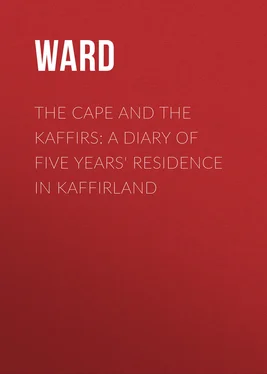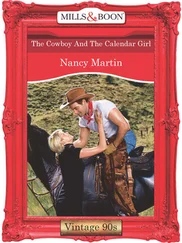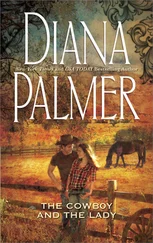Ward - The Cape and the Kaffirs - A Diary of Five Years' Residence in Kaffirland
Здесь есть возможность читать онлайн «Ward - The Cape and the Kaffirs - A Diary of Five Years' Residence in Kaffirland» — ознакомительный отрывок электронной книги совершенно бесплатно, а после прочтения отрывка купить полную версию. В некоторых случаях можно слушать аудио, скачать через торрент в формате fb2 и присутствует краткое содержание. Издательство: Иностранный паблик, Жанр: foreign_prose, История, foreign_edu, foreign_antique, на английском языке. Описание произведения, (предисловие) а так же отзывы посетителей доступны на портале библиотеки ЛибКат.
- Название:The Cape and the Kaffirs: A Diary of Five Years' Residence in Kaffirland
- Автор:
- Издательство:Иностранный паблик
- Жанр:
- Год:неизвестен
- ISBN:нет данных
- Рейтинг книги:4 / 5. Голосов: 1
-
Избранное:Добавить в избранное
- Отзывы:
-
Ваша оценка:
- 80
- 1
- 2
- 3
- 4
- 5
The Cape and the Kaffirs: A Diary of Five Years' Residence in Kaffirland: краткое содержание, описание и аннотация
Предлагаем к чтению аннотацию, описание, краткое содержание или предисловие (зависит от того, что написал сам автор книги «The Cape and the Kaffirs: A Diary of Five Years' Residence in Kaffirland»). Если вы не нашли необходимую информацию о книге — напишите в комментариях, мы постараемся отыскать её.
The Cape and the Kaffirs: A Diary of Five Years' Residence in Kaffirland — читать онлайн ознакомительный отрывок
Ниже представлен текст книги, разбитый по страницам. Система сохранения места последней прочитанной страницы, позволяет с удобством читать онлайн бесплатно книгу «The Cape and the Kaffirs: A Diary of Five Years' Residence in Kaffirland», без необходимости каждый раз заново искать на чём Вы остановились. Поставьте закладку, и сможете в любой момент перейти на страницу, на которой закончили чтение.
Интервал:
Закладка:
Harriet Ward
The Cape and the Kaffirs: A Diary of Five Years' Residence in Kaffirland
Dedication
My dear Colonel Somerset,
My work on Kaffirland, which I had the honour to dedicate to you in 1848, having gone through two editions, I should consider this abstract narrative incomplete without your name. Permit me, then, to inscribe this little book to you, in testimony of that admiration for your public services which all must feel who have benefited by them, as well as in remembrance of much kindness to
Your obliged and faithful friend,
Harriet Ward.
Dover, March , 1851.
Note. Since this was written Colonel Somerset has been awarded the local rank of Major-General by Sir Harry Smith.
Prologue
Much of the following work has already appeared, and has been favourably received by the public under the title of “Five Years in Kaffirland.” Its price, however, having necessarily limited its circulation, I have been induced to remodel it, and I now bring it forward in its present shape, with some little alteration and abridgment, and with the addition of much that appeared to me likely to render it serviceable to such of my countrymen as may be meditating an attempt to improve their circumstances by emigration, particularly if their views of where best to go are either undecided, or point in the direction of Southern Africa.
I have passed five eventful years in that country, and in what I have said of it I speak from personal experience, without any prejudices to gratify, or any party to serve, but actuated, I trust, by a sincere desire to be of service.
It is true that a cloud has again gathered over the land, but I feel justified in venturing the opinion that, under Providence, it will be dispersed by the judgment and energy of Sir Harry Smith.
The tide of emigration having lately set strongly in the direction of Natal, I have thought it necessary to give some account of that district, but as I have no personal knowledge of it, I have confined myself to the information supplied by published official reports.
Part 1
Chapter I.
British Possessions in Southern Africa
The British possessions in Southern Africa, at the present day, consist of what has long been known as the Cape Colony, or the country extending from the extreme southern point of the continent to the 29th degree of south latitude; of a district adjoining on the east, called British Kaffraria; and a detached territory, called Natal, lying far removed from the rest, on the eastern coast, and bordering on the country called Delagoa, of which the possession is claimed by the Portuguese. In so large an extent of country there is, of course, much diversity of soil and general appearance, but it is unquestionable that the parts best adapted, on the whole, to European settlement, are the eastern districts, including Natal. The extent and population of each of these divisions may be roughly stated at—Cape Colony and British Kaffraria, 150,000 square miles, and 200,000 inhabitants; Natal, 18,000 square miles, and 20,000 inhabitants. In the Cape Colony the white and the coloured population are of about equal amount, 1 1 In the Blue Book for 1847, the latest published account, the numbers stand, 71,113 white, and 75,977 coloured; but this leaves more than 21,000 of the total unaccounted for.
but in British Kaffraria and Natal the number of white inhabitants is as yet but small. Among the white inhabitants, those of Dutch origin greatly predominate, as is shown by a Government return of the various religious persuasions, in 1846, where, out of 70,310 white Christians, no less than 51,848 belong to the Dutch Reformed Church.
Southern Africa may be described as consisting of a series of terraces rising one above the other as they recede from the sea, and then declining towards the great Orange River, which, after a long course, generally from east to west, falls into the Atlantic Ocean about 500 miles north of the Cape. On the sea-shore is a belt of land, consisting of a level plain, from 10 to 30 miles in breadth, with some gentle hills, generally fertile, and enjoying a mild climate, but backed by a chain of low mountains called the Lange Kloof, or Long Pass, which support a wide table-land, or karroo, as it is termed, consisting generally of barren plains, yet well adapted to sheep-farming. Beyond, rises another mountain-chain called the Zwaarte Bergen, or Black Mountains, and further north a still wider table-land, called the Great Karroo, which is by some travellers compared to the steppes of Tartary; rain seldom falls here; the climate is rigorous at one season and excessively hot at another, and even sheep-farming can hardly be carried on. But further north, as the land slopes towards the Orange River, the climate is more equal, and the land increases in fertility, so that large herds of cattle are reared.
A somewhat similar series of terraces is found on the western coast, but their direction is north and south.
Of the rivers, much the largest is the Orange River, but from its remoteness from the settled portions of the country little use has yet been made of it. The Olifant’s, or Elephant River, and the Great Berg River, fall into the sea on the west coast; the Broad River and the Knysna on the south coast while the east coast is watered by the Sunday River, which falls into Algoa Bay; the Great Fish River, the Keiskama, the Kei, and many smaller streams. In the vicinity of the district of Natal are found the Umzimkulu, the Umlazi, and many others, of which even the names are hardly known to Europeans.
The produce of Southern Africa is mainly agricultural. In the districts in the neighbourhood of Cape Town wine is produced, while the more remote parts furnish corn and wheat. The chief exports are wine and wool, with hides, tallow, and salted beef, goat-skins, corn, and butter. The provisions are sent chiefly to the Mauritius and South America.
The exports of wool are increasing rapidly, those of wine decreasing. In 1827, only 44,441 pounds of wool were exported: in 1846, 3,000,000 pounds; while the wine had decreased in same period from 740,000 to 185,000 gallons. The white fishery, which was formerly pursued with success, has now declined, but the amount of shipping belonging to the Colony has more than doubled in the last ten years.
The Cape Colony is divided into the thirteen districts the Cape, Stellenbosch, Worcester, and Clanwilliam, in western part; Swellendam, George, and Uitenhage, in the south; Albany, in the east; and Beaufort, Graaf Reinet, Colesberg, Cradock, and Somerset, in the interior.
Cape Town, on the southern shore of Table Bay, and about thirty miles to the north of the Cape of Good Hope, is a well-built place, the streets laid out in regular lines, and some are shaded by trees. The houses are mostly of respectable size, and have a kind of terrace before the door. It is spoken of as having a more English appearance than most colonial capitals, the whole being extremely clean, and the public edifices numerous and substantial, including the Government House, the Stadthuis, or Municipality, several handsome churches, an exchange, and an observatory. The population Is nearly 30,000. Immediately behind the town rises the Table Mountain, and to the south is a district in which are found many elegant villas, surrounded by vineyards and thriving plantations.
The town next in importance is Graham’s Town, in the Albany district. This is the capital of the eastern district of the Colony. It has a population of about 7,000, and is 650 miles distant from Cape Town. It was only founded in the year 1810, by Colonel Graham, but it has many good buildings, and its merchants and traders are considered as particularly active and enterprising. Thirty-five miles off, at the mouth of the Kowie River, is the rising settlement of Port Frances.
Читать дальшеИнтервал:
Закладка:
Похожие книги на «The Cape and the Kaffirs: A Diary of Five Years' Residence in Kaffirland»
Представляем Вашему вниманию похожие книги на «The Cape and the Kaffirs: A Diary of Five Years' Residence in Kaffirland» списком для выбора. Мы отобрали схожую по названию и смыслу литературу в надежде предоставить читателям больше вариантов отыскать новые, интересные, ещё непрочитанные произведения.
Обсуждение, отзывы о книге «The Cape and the Kaffirs: A Diary of Five Years' Residence in Kaffirland» и просто собственные мнения читателей. Оставьте ваши комментарии, напишите, что Вы думаете о произведении, его смысле или главных героях. Укажите что конкретно понравилось, а что нет, и почему Вы так считаете.












